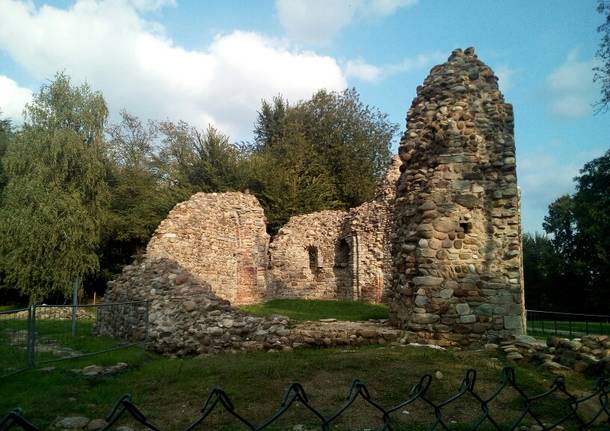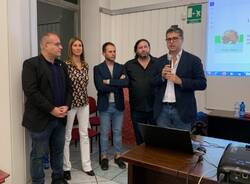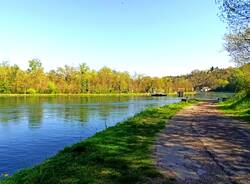Tremona, “the other Castelseprio”, on the other side of the border
The ancient settlement-castle, which was brought to light only at the end of Twentieth Century, was inhabited from prehistory, until it was abandoned in the late Middle Ages

Across the border between Italy and Switzerland, there is an another Castelseprio. It is not a twin (as it is less rich, powerful and well-known), but is certainly similar, in its troubled history, to the castrum “capital” of Seprio, which was destroyed by Milan in 1287. It is the ancient Tremona, the fortified settlement on top of a mountain, 600 m above Mendrisio.
Today, in the middle, there is the border between Italy and Switzerland, between Varese Province and Canton Ticino. But this is a recent border, that does not reflect the history that, for centuries, was shared by these two lands. Archaeological excavations, and subsequent studies over the last twenty years have enabled us to understand that the town of Tremona (which was all but forgotten from memory) was “inhabited from prehistory to the fourteenth century, when the castle was abandoned after a violent event, a siege,” said Elena Percivaldi, historian and keen populariser of the rediscovered site near Mendrisio, which, in September, was introduced into a genuine archaeological park.
(A 3D reconstruction of the settlement: the archaeological park also provides hi-tech visiting tools, including augmented reality.)
The story of Tremona started in prehistory (from Neanderthal man to the Neolithic period, up to the Iron Age) and continued until the end of the Middle Ages, when the settlement (which had already been dismantled after a siege) disappeared for good, into an “abyss” that swallowed up all memory of it for half a millennium, until the end of the twentieth century. “A destiny that paralleled that of Castelseprio,” Percivaldi explained. In 1988, the archaeologist Alfio Martinelli (who subsequently founded the Archaeological Research Association of the Mendrisio Region – Associazione Ricerche Archeologiche del Mendrisiotto), visited the wooded mountain, and recognised the existence of city walls, saw in the stones the foundations of ancient buildings, and divided some ancient, iron findings from the shell casings left by the Swiss Army, who, here, near the border, carried out training “manoeuvres” in the twentieth century.
Starting in 1991-1993, the excavations have, over time, enabled the identification of “an extremely complex and stratified settlement.” A castle, a military garrison, but also a centre of power, with a stable population, able to produce handicrafts, to trade using coins of various origins, and to accumulate wealth. There is a central building (maybe a church, although researchers cannot agree), various circles of wall gradually restructured, at least one house-tower, buildings built first in wood, during the Roman era, and then increasingly also in brickwork.
Another element that unites Tremona and Sibrium (that is, Castelseprio) is the presence of the Longobards, the topic, on Sunday, 12 November, of a talk by Percivaldi, at the conference at Villa Cagnola dedicated to the ancient Germanic people who arrived in Italy in the sixth century, to replace (and incorporate) the power of the Romans, which was in disarray. Here too, the Longobard presence replaced the Romans, thereby keeping this small town going. Of course, the differences between Castelseprio and Tremona are not insignificant: in the hills of Varese was a recognisable centre of power that was so refined as to build three different churches, with frescoes and sculpted decorations; on the mountain above Mendrisio, a community that was still struggling to survive. Today, the main traces are the sepulchres from the time of the Longobards, between the 6th and the 8th centuries: a pregnant woman in her 28th week of pregnancy, a very small, four-year-old child (80 cm), evidence of a “fragile” population.
(The conference on the Longobards at Villa Cagnola, which brought scholars and enthusiasts from all over Italy, from Friuli to Benevento).
There is a lot of evidence of Tremona, discovered among buildings and walls, but also in a crevasse beneath the town, used for millennia as a dump, by various peoples. The climax was reached perhaps during the period of the county of Seprio, when Tremona guarded the Sibrium-Riva San Vitale road, between the main centre of Seprio and the area to the north, towards Ceresio. After a brief period of depopulation, in the second half of the 12th century, the settlement was repopulated, the wall was moved back and given a new entrance, and new houses were added. The finding of silver coins from Como, Milan, Brescia and Cremona suggests a period of medium-range trade and renewed wealth (the excavations discovered locks and keys, three times as many as the buildings: not only entry doors, so, perhaps also trunks and chests).
However, Seprio was too difficult for the growing towns, between Como and Milan. In 1242, the Milanese laid siege to Mendrisio and Bellinzona and “in these decades, Tremona was also destroyed.”
This is demonstrated (as it is in Castelseprio) by the traces of fire, but also the great number of arrowheads found. The end of the castle in the Mendrisio region was therefore contemporary with that of Castelseprio, conquered perhaps by deception, and razed to the ground by Milan, in 1287.
Both sites were abandoned for good at the end of the Middle Ages, and all traces of both were lost, until the twentieth century, when they were brought to light, first Castelseprio (which, together with Torba, is today part of a UNESCO heritage site, the “Longobards in Italy – the places of power“), and, more recently, Tremona. This great historical asset unites two territories.
La community di VareseNews
Loro ne fanno già parte
Ultimi commenti
malauros su I no vax sono tornati a colpire in provincia: imbrattati i muri della redazione di Varesenews
Felice su I no vax sono tornati a colpire in provincia: imbrattati i muri della redazione di Varesenews
PaoloFilterfree su A Varese Salvini prova a ricucire passato e futuro della Lega, ma Bossi non c'è
axelzzz85 su A Varese Salvini prova a ricucire passato e futuro della Lega, ma Bossi non c'è
elenera su A Varese Salvini prova a ricucire passato e futuro della Lega, ma Bossi non c'è
Roberto Colombo su A Varese Salvini prova a ricucire passato e futuro della Lega, ma Bossi non c'è














Accedi o registrati per commentare questo articolo.
L'email è richiesta ma non verrà mostrata ai visitatori. Il contenuto di questo commento esprime il pensiero dell'autore e non rappresenta la linea editoriale di VareseNews.it, che rimane autonoma e indipendente. I messaggi inclusi nei commenti non sono testi giornalistici, ma post inviati dai singoli lettori che possono essere automaticamente pubblicati senza filtro preventivo. I commenti che includano uno o più link a siti esterni verranno rimossi in automatico dal sistema.